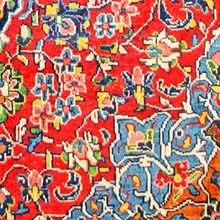Ahar Rug
| Ahar Rug | |
|---|---|
 Design of Ahar Rug (Rugman) | |
| General information | |
| Name | Ahar Rug |
| Original name | قالی اهر |
| Alternative name(s) | Ahar Carpet |
| Origin | |
| Category | Village |
| Technical information | |
| Common designs | Medallion, Geometric |
| Common colors | Red, Beige, Blue, Navy Blue |
| Dyeing method | Natural, Synthetic |
| Pile material | Wool |
| Foundation material | Cotton |
| Knot type | Symmetrical (Turkish) |
Ahar rugs originate from the small village in the mountainous district of Azerbaijan in northwestern Iran, near Tabriz and Gharabagh. One of the distinguishing features of these rugs is its size. Mainly smaller pieces and runners, these rugs are created using a special symmetrical Turkish double knotting method which produces a dense and tightly packed area rug. Known for its exquisite semi-nomadic appearance, they are regarded as a form of tribal art. The style of weaving is very bold, creating a very dramatic look.
History
Ahar is a city located in the East Azerbaijan Province of northwestern Iran. The population is Azeri tribe in origin, speaking a Turkic dialect. Ahar is situated close to the famous weaving town of Heriz. Ahar carpets use a Heriz design style and are grouped under Heriz carpets. Carpet production began in Ahar when demand for Heriz carpet designs grew in the world marketplace during the turn of the twentieth century. The rugs and carpets have a cotton foundation and a wool pile. The Turkish (symmetric) knot is employed.
Ahar designs are nearly or quasi-geometric, featuring either a medallion or an allover pattern. The carpets are well known for having a large center medallion style with quartered corners. The medallions in Ahar carpets have an identifiable circular or elliptical shape and larger, bolder motifs compared to traditional Heriz group weavings of the 1920s. The motifs include stylized palmettes, leaves, and vines, with primitive nomadic design elements.
Ahar carpets can also be identified by their double wefts, which were hammered tightly for durability as a floor covering. After World War II, a great quantity of Ahars were produced for domestic demand and exported for the Western market.
The carpets generally have a brick-red or deep red background. Dark blue was used for the medallion and border. In addition to these colors, ivory, camel, and shades of red, blue, green, rust, and brown were utilized for the design elements. Dark brown or black was used for design outlines.
The formats range from small mats to carpets approximately fourteen feet by ten feet. A majority of Ahars were made in the standard dimensions of twelve feet by nine feet. The carpets are good in grade quality and are known to be durable. Ahar carpets from the 1920s era are valued at approxi-mately $80 a square foot.[1]
See also
References
- ↑ Moheban, 2015, 41
Bibliography
- Abraham Levi Moheban. 2015. The Encyclopedia of Antique Carpets: Twenty-Five Centuries of Weaving. NewYork: Princeton Architectural Press.